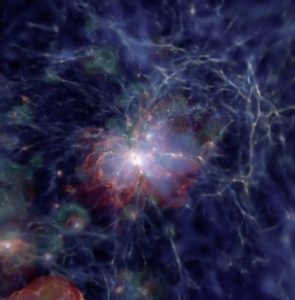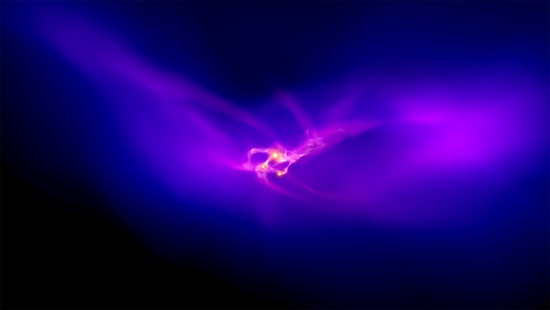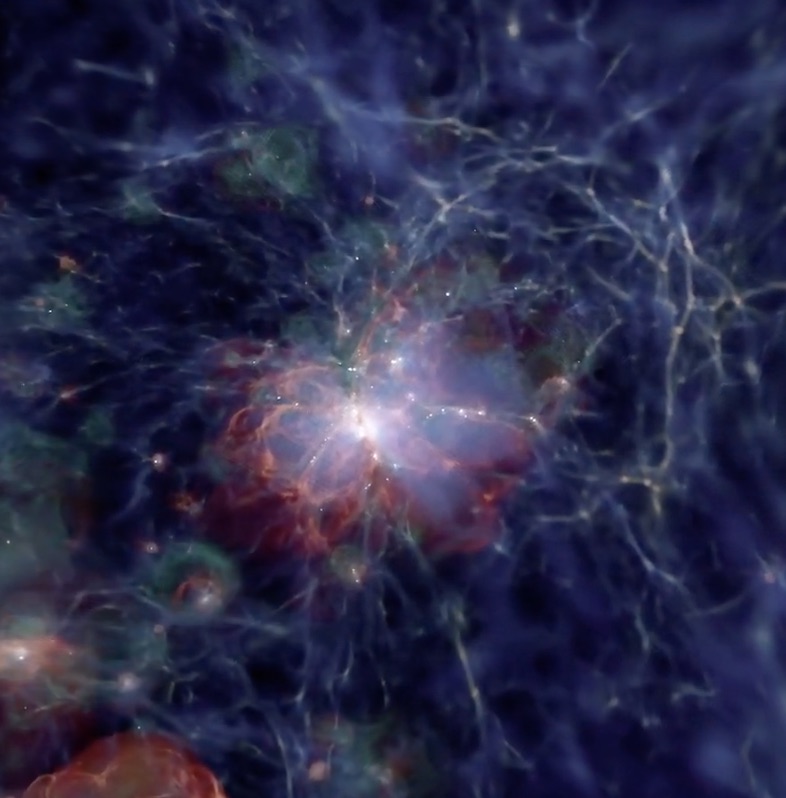 New research based on simulations using the Blue Waters supercomputer at NCSA reveals that when galaxies assemble extremely rapidly — and sometimes violently — that can lead to the formation of very massive black holes. In these rare galaxies, normal star formation is disrupted and black hole formation takes over.
New research based on simulations using the Blue Waters supercomputer at NCSA reveals that when galaxies assemble extremely rapidly — and sometimes violently — that can lead to the formation of very massive black holes. In these rare galaxies, normal star formation is disrupted and black hole formation takes over.
We on the Blue Waters Project are very excited about this accomplishment and very pleased that Blue Waters, with its unique capabilities, once again enabled science that was not feasible on any other system.”, said Bill Kramer, the Blue Waters Principal Investigator and Director. “We look forward to helping continue these great research efforts.”
This new study, published in Nature and supported by funding from the National Science Foundation, the European Union and NASA, is led by researchers from Georgia Institute of Technology, Dublin City University, Michigan State University, the University of California at San Diego, the San Diego Supercomputer Center and IBM. Their research finds that massive black holes form in dense starless regions that are growing rapidly, turning upside down the long-accepted belief that massive black hole formation was limited to regions bombarded by the powerful radiation of nearby galaxies. Conclusions of the study, also find that massive black holes are much more common in the universe than previously thought.
The research was based on the Renaissance Simulation suite, a 70-terabyte data set created on the Blue Waters supercomputer, and visualized for documentaries and the World Wide Web by NCSA’s Advanced Visualization Laboratory between 2011 and 2014 to help scientists understand how the universe evolved during its early years.
The formation of massive black holes is a rarity in the universe, requiring a simulation of a large cosmological volume while resolving the smallest scales around the black hole,” said John Wise, an associate professor in the Center for Relativistic Astrophysics at Georgia Tech and the paper’s corresponding author, “The tremendous capabilities of Blue Waters enabled us to run a simulation with a large dynamical range while probing thousands of galaxies. Our discovery would not have been possible without Blue Waters.”
To learn more about specific regions where massive black holes were likely to develop, the researchers examined the simulation data and found ten specific dark matter halos that should have formed stars given their masses but only contained a dense gas cloud.
Blue Waters was crucial to the success of this project. At the time we ran the simulations, Blue Waters was the only fully open research supercomputer in the US that had the capability to execute these calculations – it has large memory and a fast interconnect, and also an extremely fast file system. All of those things are critical to huge, multi-physics simulations like the Renaissance Simulations, and were very important in executing the simulation and also in our analysis of the resulting huge volumes of data,” said Brian O’Shea, a professor at Michigan State University and Principal Investigator of the Blue Waters allocation used for the calculations of this work.

Zoom of the inner 30 light-years of the dark matter halo. The rotating gaseous disk breaks apart into three clumps that collapse under their own gravity to form supermassive stars. (Photo Credit: John Wise, Georgia Institute of Technology)
The Renaissance Simulations are the most comprehensive simulations of the earliest stages of the gravitational assembly of the pristine gas composed of hydrogen and helium and cold dark matter leading to the formation of the first stars and galaxies. They use a technique known as adaptive mesh refinement to zoom in on dense gas clumps forming stars or black holes. In addition, they cover a large enough region of the early universe to form thousands of objects—a requirement if one is interested in rare objects, as is the case here.
The improved resolution of the simulation done for two candidate regions allowed the scientists to see turbulence and the inflow of gas and clumps of matter forming as the black hole precursors began to condense and spin. Their growth rate was dramatic.
Astronomers observe supermassive black holes that have grown to a billion solar masses in 800 million years,” Wise said. “Doing that required an intense convergence of mass in that region. You would expect that in regions where galaxies were forming at very early times.”
Another aspect of the research is that the halos that give birth to black holes may be more common than previously believed.
An exciting component of this work is the discovery that these types of halos, though rare, may be common enough,” said O’Shea, “we predict that this scenario would happen enough to be the origin of the most massive black holes that are observed, both early in the universe and in galaxies at the present day.”
Future work with these simulations will look at the lifecycle of these massive black hole formation galaxies, studying the formation, growth and evolution of the first massive black holes across time.
For these new answers, the research team — and others — may return to the simulations.
Source: NCSA




